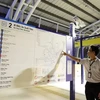The capital city, which merged with several pats of the adjacent rural provinces of Ha Tay and Hoa Binh in 2008, is waiting for Government approval of its project for “New lifestyle Rural Areas” for 2020 with orientations for 2030.
The project calls for sustainable economic development, including massive investment in infrastructure and the improvement of people’s living conditions, both material and cultural.
The scheme’s budget is estimated at almost 32 trillion VND (roughly 1.7 billion USD).
The funding is for rural facilities such as transport corridors, irrigation projects, electricity, schools, medical stations, traditional markets and housing.
The city also plans to review out-of-date policies regarding agriculture, farmers and rural areas to work out new appropriate revisions.
The new plan encourages local technicians and managers to work in the countryside. It also offers credit to farmers to either start up or develop household economies, as well as measures to train high-quality human resources to meet the demands of rural development in the new stage.
Top investment priorities include heavy industry and light industry along with handicrafts, traditional craft villages, markets and services aimed at generating large numbers of jobs and improving living conditions for farmers./.
The project calls for sustainable economic development, including massive investment in infrastructure and the improvement of people’s living conditions, both material and cultural.
The scheme’s budget is estimated at almost 32 trillion VND (roughly 1.7 billion USD).
The funding is for rural facilities such as transport corridors, irrigation projects, electricity, schools, medical stations, traditional markets and housing.
The city also plans to review out-of-date policies regarding agriculture, farmers and rural areas to work out new appropriate revisions.
The new plan encourages local technicians and managers to work in the countryside. It also offers credit to farmers to either start up or develop household economies, as well as measures to train high-quality human resources to meet the demands of rural development in the new stage.
Top investment priorities include heavy industry and light industry along with handicrafts, traditional craft villages, markets and services aimed at generating large numbers of jobs and improving living conditions for farmers./.



















